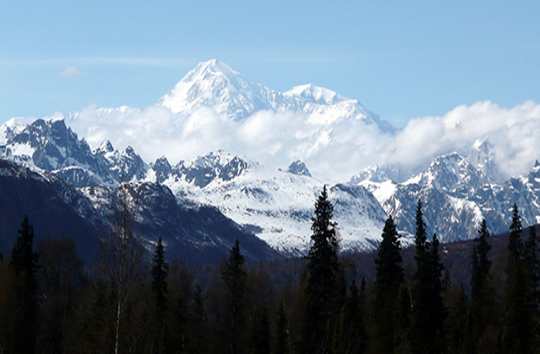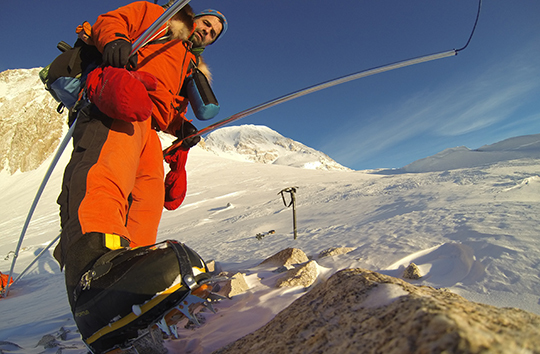
[Photo] Richard Moore
On Sunday, January 11, the polar adventurer Lonnie Dupre, of Grand Marais, Minnesota, stood atop Denali (20,320′), having become the first person to make a January solo ascent of the mountain. His one-man expedition, which began December 18 when he was dropped off at Kahiltna Basecamp with thirty-four days of supplies, marked the fourth year he’d attempted to solo the mountain in winter. In 2011 Dupre reached 17,200 feet only to be trapped for a week by a ferocious storm; in 2012 he reached 15,400 feet; and in 2013 he reached 17,200 feet again only to have to turn around a final time. Dupre had summited the peak in 2010 with three partners over thirteen days, and he had spent sixty days total on the flanks of Denali during his previous winter attempts; his 2015 climb brought his total number of winter days on Denali to ninety.

[Photo] Lonnie Dupre
Dupre’s choice of ascent in 2015 was the West Buttress, the trade route up the mountain. Only one other party has topped out Denali in January, the Russians Artur Testov and Vladimir Ananich, on January 16, 1998, also via the West Buttress. (The third member of their team, Alexander Nikiforov, waited for them in a snow cave at 14,200 feet.) A mere sixteen people–members of nine expeditions–have summited Denali in winter; six deaths have occurred during those climbs. Four of these nine expeditions were solo, but none of the previous solo climbers summited in January, a time of year with six or fewer hours of daylight, winds that can top 100 mph, and temperatures well down to -30 to -40 degrees. As the Alaska climber Jeff Benowitz puts it, in such conditions, the extreme cold and lack of sunlight make it hard to dry out your sleeping bag, which “night after night starts to become a sack of ice crystals.”
Dupre is certainly not the first solitary climber to suffer such harsh winter weather in the Alaska Range. Among other soloists, the Japanese climber Masatoshi Kuriaki once stated in an Alpinist interview that he had spent 706 days total by himself in the range during the coldest months. On March 10, 2007, Kuriaki had made the first winter solo of Mt. Foraker (aka: “Sultana”), summiting while the air temperature was -50 F, with a 20-30-knot gale dropping it to -100 F. Anyone who attempts these peaks, so close to the Arctic Circle, in winter must be prepared to suffer–and to work, hard. Low on the mountain, Dupre pulled a sled with 165 pounds of supplies; on the upper slopes, he portaged his gear in a pack. Here he shares more details of his ascent in an interview.

[Photo] Lonnie Dupre
Did you experience 100 mph winds?
The highest winds I experienced were 80 mph based on my past twenty-five years of running around the Arctic. I wasn’t carrying an anemometer. You can tell the speed of the wind by [whether] you can stand up or not. It’s impossible to walk around outside when it’s blowing around at 80 mph; I was in a snow cave. When the wind gets at high velocity like that, it sounds like a train. To survive in snow caves, you have to make sure the snow is consolidated because otherwise your snow shelter can get excavated [by] the wind. You’re safer in a cave than you are in a tent in the wind. You always have to think about the winds–where they are coming from and where they are the strongest.
Being caught out in the wind is bad. You just have to stop and dig in. I would dig down a 4′ x 4′ x 4′ cube and then trench out my feet and roster out snow blocks for the roof and pile fresh snow on top. The modified snow shelter that I built is superior to a snow cave. In other snow caves, you lie down and shovel out. It’s better to be on your feet, dig straight down and make snow blocks for the roof.
Did you carry/wear a ladder, to keep from falling into crevasses?
I’ve used a ladder, which is heavy and awkward. Another year, I used aluminum poles prussiked to my harness. Then I used a twelve-and-a-half-foot by three-inch skinny spruce pole to keep out of crevasses. It’s the longest pole I can fit into an airplane.
I always think it’s better to be hanging precariously by your spruce pole than stuck in a crevasse. If you go down a crevasse and you get wedged, you’re finished. There are ways [to] wedge the pole in the ice and prussik up it. It’s almost like having a ladder. My skis [provide] 90 percent of my protection [and] keep [me] from going down in the crevasse in the first place. Nothing’s fail-safe though.
Tell me a bit about your skis.
They’re specially designed from yellow birch from my property in northeast Minnesota, in Grand Marais (“big swamp” in French). [The wood] is very tough and can be laminated very well.
The tree was dragged out by draft horses and then cut on a portable land mill and dried for two years. Then I steam vented, added camber, toe and heel work, and shaped the skis to be four inches wide and eight feet long. I pine-tarred them and epoxied the base. This allows the skis to breathe a bit, and having an epoxy bottom gives a smooth glide and helps the skins to stick.
Tell me about the first few hours of your day on Denali.
There is such a short window of light, about four to six hours a day. In the middle of December, you only have five-plus hours of usable light; by the end of January, you have seven. I’d turn on my headlamp, get the frost out of my tent, take the sleeping bag outside so it doesn’t get frosty, melt water and cook goat milk and granola, rice pudding and [dehydrated] huevos rancheros.
[I’d] tie my sleeping bag to the tent stay [so it won’t blow away], rub it in the snow to have it suck up moisture and then scrap the snow off and bang the sleeping bag good to get the rest of the snow off. [Then I’d] just roll it up and put a rope around it. No sense freezing your fingers stuffing it in a bag.
How did you pass the time when you weren’t climbing?
Because the days are short with long nights, when I was stuck in one spot and short of supplies, I would go into hibernation mode. I just stayed in my sleeping bag as long as I could. I broke my old record of sixteen hours and did several days of nineteen hours. It’s good to get out once or twice a day to get your muscles moving, so you don’t atrophy [and to] do chores no matter how mundane they may be [such as] shovel snow and make extra snow blocks.
Do you picture your loved ones back home to pass the time?
When those things creep in, the only way you can get through is to compartmentalize. You have to remove them from the front of your brain. Not to be uncaring–it’s just a matter of survival. It takes years of experience to deal with it.
What was the cold like?
A January ascent is cold and dark, mainly. My forte prior to Denali was having a lot of polar experience. My training happened over the past couple of decades. I’ve experienced -58 F without windchill on the North Pole and Greenland. That’s so cold that peanut butter shatters like glass, and white fuel pours out like syrup; even steel gets brittle at those temps. Still, you have warm clothes and your body becomes adapted. You need to have reserve in case the crap hits the fan.
Tell me about the recent storm that pinned you down on Denali.
I was stuck at 11,200 feet in a five-and-a-half-day storm. But I only had one-and a-half days of food and two-and-a-half days of fuel with me. I’d cached my supplies a ten-minute ski away [but] the weather was so bad I couldn’t go get them. I had to parse out my food, and I was getting cranky.
What links did you maintain with the outside world?
I [brought a] Spot beacon [and satellite phone to] allow my project coordinator, Stevie Plummer, to know where I am and that I’m OK.
What was the most important tool for your success?
My skis, because there was heavy snow. Without my skis, I couldn’t even have started. After 11,200 feet, I went up with crampons and a sled. Then, at 14,200 feet, it was crampons and a backpack to 17,000. From 17,000 to the summit, it was crampons and an ice axe–that’s all I had.
How did you acclimate?
Simply by double carrying–I basically climbed the mountain twice. I would bring half my equipment up 10,000 feet, then hike back down and camp. I would hop scotch my gear up since I couldn’t carry it all up [at once] anyways.